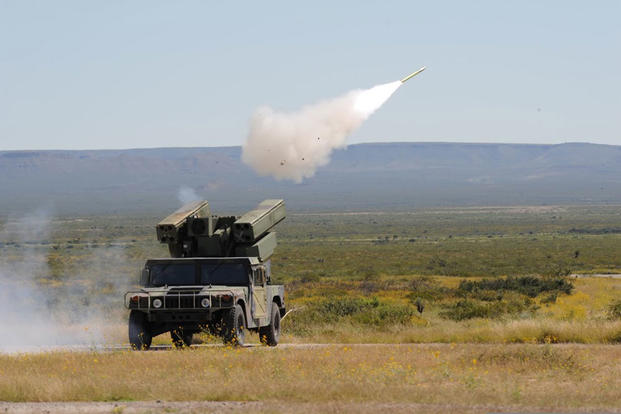The U.S. Army -- racing to add thousands of soldiers to its ranks this year -- plans to hold end-strength flat in fiscal 2018 in part to boost funding for armored forces in Europe and missile defense systems.
The service has requested a total budget for the fiscal year beginning Oct. 1 of $166 billion, an increase of about $15 billion, or 10 percent, from the recently enacted fiscal 2017 spending plan, according to a budget overview released by the Pentagon.
That topline figures includes a base budget of $137 billion and a war budget of $29 billion for overseas contingency operations, or OCO.
Excluding revolving funds, the budget line with the biggest percentage increase year-over-year was military construction, at 44 percent; followed by research and development, 25 percent; operation and maintenance, 13 percent; family housing, 10 percent; procurement, 7 percent; and personnel, 4 percent.
The spending plan "takes important steps to improve readiness and close some vulnerability gaps while supporting the groundwork for a future force ready to face the changing threats of tomorrow," said Maj. Gen. Thomas Horlander, director of Army budget.
"The recently enacted fiscal 2017 budget and this fiscal 2018 request are consistent with this administration's goals for the U.S. Army to rebuild readiness, reverse end-strength reduction and prepare for future challenges," he added.
End-Strength
The budget continues to support the increased end-strength of all components mandated in the fiscal 2017 National Defense Authorization Act, including the move to increase the active force from a previous target of 450,000 to 476,000 in fiscal 2017.
The Army is requesting $41.8 billion for a 476,000-member active force, $8.4 billion for a 343,000-member National Guard and $4.8 billion for the 199,000-member Reserve force, according to the 2018 figures.
The spending plan identifies air and missile defense, long-range fires and critical munitions shortfalls as the Army's top priorities for fiscal 2018. The items were identified through a Strategic Portfolio Analysis Review Process, Horlander said.
"The air and missile defense and the long-range fires represent the Army's most urgent and pressing capability needs," he said.
Air Defense, Long-Range Fires
"Given the possibility of confronting a force with anti-access and area-denial capabilities, the Army needs to advance its short-range air defense and long-range fires capabilities."
The budget funds 131 Patriot Missile modification kits and the investment in the Avenger Surface to Air Missile system supports an interim modernization, Horlander said.
The Army is also investing $2.4 billion in science and technology for weapons and munitions advanced technology which will "demonstrate a mobile high-energy laser system designed to defeat multiple threats at the tactical range," Horlander said.
The research, development, test and evaluation budget invests in the Stinger and the Patriot missile system product improvement programs, He said.
For long-range fires to improve ability to respond to surface to surface fires from cannon and rocket artillery, this budget request includes funding for three of the Army's most critical fires systems:
- A service life extension of 121 expired Army Tactical Missile Systems which will add another 10 years of service life.
- Procurement of 6,000 Guided Multiple Launch Rocket Systems, compared to last year's 2,954 systems.
- Continues low-rate initial production of 93 Patriot Missile enhancements.
The budget request also funds the replenishment of key battlefield munitions such as the increased production of more than 88,000 unguided Hydra 70 rockets and the procurement of 998 Hellfire missiles, Horlander said.
Vehicle Protection
The Army funds the future procurement of commercially available active protections systems to detect and defeat incoming anti-tank guided missile threats to M1 Abrams Tank and Bradley fighting vehicles in the armored brigade combat team in Europe, Horlander said.
"We really need to have a more robust capability for a major force-on-force combat operation with near-peer competitors and those that have some pretty sizable armored formations," he said.
The budget also funds 135 modernized Bradley fighting vehicles and 2,110 Joint Light tactical vehicle 2,110 compared to last year's 1,828.
Aircraft procurement did take a hit in this budget -- $4.2 billion compared to last year's $4.9 billion.
Helicopters
The Army will procure 63 AH-64E Apaches, but only 48 UH60M Black Hawk helicopters compared to last year's buy of 60, according to budget documents. The Army will only buy six CH-47 Chinooks, compared to 2017's purchase of 22 Chinooks.
The aviation portfolio is one of the largest in the modernization budget, accounting for about 25 percent, said Horlander, conceding that aviation assets had to be sacrificed for air and missile defense systems.
"There were certainly a couple of things we chose to fund as opposed to more aviation capabilities," Horlander said.
-- Matthew Cox can be reached at matthew.cox@military.com.






























